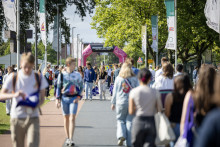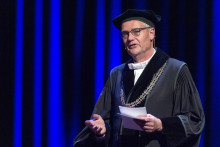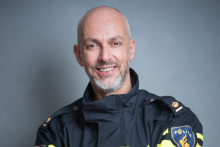Srininvas Vanapalli, (TNW) one of the main organizers says, `My international friends showed a lot of interest in India, but they were aware only of India's weaknesses as portrayed in the media. I had a burning desire to showcase our strengths and beauty, hence we internationalized Diwali this year'.
It is believed that `Diwali' is a corruption of the word `Deepavali,' the literal meaning of which in Sanskrit is `a row of lamps.' Filling little clay lamps with oil and wick and lighting them all over the house is a tradition that is synonymous with Diwali.
As is the custom, the celebration in the Bastille began with a prayer to the Indian Goddess of Wealth, Lakshmi, for blessings of prosperity for everyone. The cultural events commenced with Indian singers belting out a popular love duet, lending the right ambiance. The next offering was a skit in the Indian national language, Hindi, about an Indian's journey to hell and the mythological characters like the God of Death he encounters. The international guests were given the background so that they could also appreciate the events. The skit was written and directed by Makarand Pimplapure (TNW).
This was followed by an instrumental recital by Supriyo Chatterjea (EWI), a Singaporean of Indian origin on the `tabla' (Indian drums) and Aditya Mehendale (EWI) on the flute. Their second song revved up the hitherto slow tempo with a fusion dance which had Indian, Western and Arabic influences had the audience whistling and gasping for more. Vasughi Sundramurthy, a Malaysian of Indian origin (EWI), the principal dancer of the quartet, attended belly-dancing classes during her four-month project work in the USA and was more than willing to display those delicious moves.
After feasting their eyes on Indian culture, the audience was invited for a gustatory feast. AADHAAR, a charity organization formed by students at the UT, had laid out a mouth-watering array of Indian dishes. In an arrangement with the organizers, an amount of 8 euros out of the 12 euros (ticket price) will be diverted towards charity causes in India. Cooking for 150 people is no joke for students, so the wise AADHAAR volunteer, Pramod Agarwal (TNW), consulted a catering service in India for useful tips and advice. It certainly paid off, with many international guests requesting for recipes.
Another highlight of the evening was a rocking performance by the band `Whipp'em and the Dandies' in which our very own Professor Willem Vos (TNW) moonlights as a drummer. Their rendition of the number `Smooth' was indeed very smooth.
The organizers definitely saved the best for last: a free-for-all dance party. A compilation of Hindi and English numbers worked their charm on the audience as alternately Western, Indian and Arabic dance moves were displayed on the dance floor by one and all. One Dutch AADHAAR volunteer made a curious observation, `The Indian men and women were dancing separately in their own circles. That was rather strange to me.'
Despite a few shortcomings - like lack of subtitles for the Hindi play, inadequate background on the mythology of Diwali itself, noisy latecomers and a less than perfect sound system - it appeared that nearly everyone was able to find something that sparked their Diwali.








